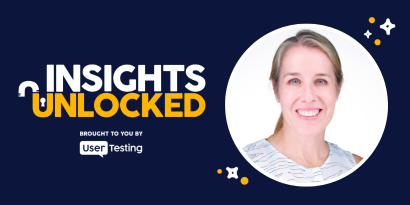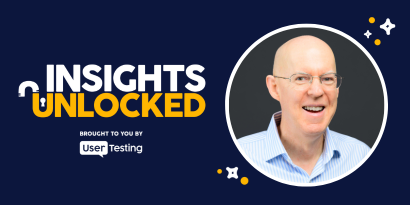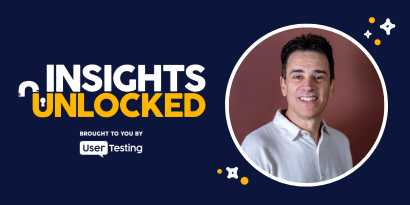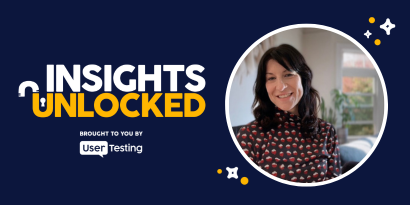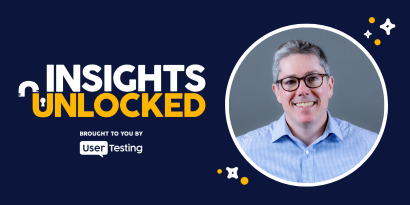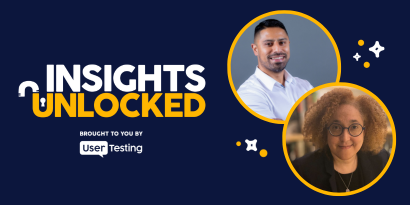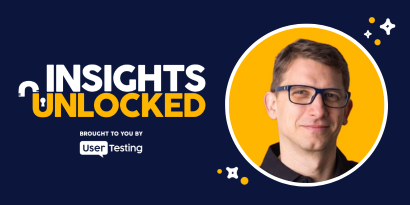
Episode 183 | August 11, 2025
Conversion copywriting starts with customer research
Learn how Chris Silvestri uses customer research and user testing to craft conversion copy that resonates. Real insights, not guesswork, drive results.
Conversion copywriting starts with customer research
Most marketing teams get this wrong: they start writing before they start listening.
But if you're crafting copy that’s supposed to connect, convert, and compel action, jumping straight to the keyboard is like building a house without checking the ground beneath it. You might get something that looks fine—but don’t be surprised when it doesn’t hold up.
On a recent episode of Insights Unlocked, conversion copywriter Chris Silvestri joined host Nathan Isaacs to break down why conversion copywriting is more about research than words. Chris, founder of Conversion Alchemy, works with B2B SaaS companies to help them find message-market fit through customer insights, usability testing, and strategy frameworks that scale.
Writing isn't the first step—it’s the last
Chris doesn’t see himself as a writer in the traditional sense. “The real secret to good writing is putting yourself in other people's shoes,” he explained. “Copy almost writes itself once you get that empathy.”
That empathy comes from customer research—lots of it. In fact, Chris estimates that 70% of his work is research. He leans on a combination of user testing, customer interviews, session replays, and review mining to shape everything from a homepage headline to a full-scale campaign.
Some of the go-to methods he uses to gather insights:
7–10 customer interviews per persona
5 user tests per ideal customer profile (ICP)
200+ online reviews from trusted platforms
But quantity alone isn’t enough. What signals that it’s time to move from research to writing?
“You know you’re ready when patterns start emerging,” Chris said. “You start seeing the same insights, the same voice of customer come up again and again. That tells me we’re onto something.”
ON-DEMAND WEBINAR
Tactical (and practical) tips to get fast feedback for better marketing
Why assumptions are the enemy of good messaging
Many marketing and product teams fall into the trap of writing from the inside out. They lean on product specs, internal jargon, or assumed customer pain points—often without validating those ideas with real users.
Chris has a simple litmus test when he starts a project:
“I always ask, ‘How many customers have you talked to recently?’ If the answer is none, we need to stop and do some research.”
He also interviews cross-functional team members—founders, marketers, sales, support—to evaluate how aligned (or misaligned) their understanding of the customer truly is. It’s not uncommon, he says, to find sales decks, websites, and product pitches all telling a slightly different story. That lack of alignment leads to unclear, ineffective messaging.
Here are a few red flags that suggest a team is guessing, not grounding:
Buzzword-heavy copy with little specificity
Constantly tweaking words on the homepage without clear rationale
Different messaging strategies across platforms (website vs. sales vs. ads)
Lack of a central messaging framework or documented research
Real feedback beats A/B testing every time
There’s a major difference between testing what works and understanding why something works. That’s why Chris leans heavily on usability testing and observing user behavior directly.
“A/B testing will tell you what’s not working,” he said. “But it won’t tell you why.”
User testing, on the other hand, offers a window into the user’s decision-making process, pain points, and expectations. Chris finds enormous value in watching users read aloud website copy, click through flows, or struggle with clunky interfaces. Even fuzzy feedback like “this feels too corporate” can spark important changes—if you know how to decode it.
His approach to analyzing fuzzy feedback:
Observe the context in which feedback is given
Ask users what they expect to happen before they take action
Cross-reference vague statements with review data and interviews
Use voice of customer data to rewrite copy in clearer, more resonant terms
ON-DEMAND WEBINAR
Unlock higher conversions: understanding what users really want
Organizing insights like an iceberg
Doing the research is one thing. Organizing it in a way that makes it usable—for yourself, for AI tools, or for a client—is another. Chris uses what he calls the “iceberg framework” to structure his findings.
Here’s how it breaks down:
Surface layer: What customers say
Think: review mining, support tickets, sales call transcripts
Structural layer: What customers do
Think: user testing, heatmaps, product analytics
Deep layer: Why customers act
Think: interviews, surveys, in-depth behavioral research
This structure makes it easier to extract value depending on your goals. Need language for ad copy? Tap into the surface layer. Looking to understand decision-making triggers? Go deeper.
Once the research is organized, Chris distills everything into two core deliverables:
A positioning canvas (who you help, how you help, what makes you different)
A messaging strategy doc (value propositions, tone, themes, proof points)
These documents don’t just power great copy—they become living systems that teams can use, edit, and feed into AI tools without losing the human insight at the core.
Using AI without losing authenticity
There’s no denying that AI copywriting tools are here to stay. But as Chris points out, they’re only as smart as the inputs you feed them.
“Most people use AI to skip the hard work,” he said. “But if you haven’t done the research, you won’t even know if what it generates is right.”
Chris uses AI to scale and collaborate. He prefers working with platforms that allow for shared workspaces, document integration, and customized tone of voice—making it easier to produce first drafts that actually sound like the brand.
To reduce the risk of bias or blandness, he:
Feeds AI tools well-organized research documents
Creates contrast personas (e.g., happy customers vs. churned customers)
Tests copy variants through synthetic personas for faster, low-risk validation
The promise and practicality of synthetic personas
One of the more intriguing parts of the episode was Chris’s take on synthetic personas—AI-generated personas built from real customer data. While some marketers are skeptical, Chris sees them as a useful tool to complement (not replace) real human research.
He shared a few use cases:
Validating early messaging before launch
Identifying objections or hesitations in different buyer types
Testing how a founder’s vision aligns (or doesn’t) with customer needs
In one case, he even created a synthetic persona modeled after a difficult client.
“We tested the copy with that persona before sharing it. The feedback we got was eerily similar to what the real client ended up saying.”
Synthetic personas aren’t magic, but when grounded in actual data, they can offer speed, scale, and an extra layer of confidence in your message-market fit.
Simplicity isn’t the goal—clarity is
One of the most common copywriting myths is that your language should always be simple. Chris challenges that idea, especially in B2B SaaS.
“Simple isn’t always better. Clear is better,” he said.
To write clear, high-converting copy, you need to know:
Your audience’s level of awareness (of their problem, the solution, and your product)
The sophistication of their language (technical terms, industry slang)
Where they are in the customer journey
Armed with that context, you can use voice of customer data in a way that matches the audience—not dumbs things down. For some, that means plain English. For others, it might mean speaking their specialized language.
Final thoughts
Chris’s advice is a reminder that effective copy doesn’t begin with writing—it begins with listening, observing, and organizing what you learn. The words are important, but they’re just the output of a much deeper process.
Whether you’re a marketer, UX researcher, or product leader, the takeaway is the same: Don’t guess what your customers need to hear. Go find out.
We’ll leave you with one final quote from Chris that captures the essence of his approach:
“Once you can put yourself in other people’s shoes, the copy doesn’t feel like writing—it feels like translating.”
Episode links:
- Chris Silvestri on LinkedIn
- Conversion Alchemy website
- Nathan Isaacs on LinkedIn
- How to democratize and scale user feedback: A 90-minute session led by user research and strategy experts, focusing on empowering teams across marketing, product, and UX to leverage real user insights broadly—perfect for exploring user testing and research-driven copy.
- Boost website conversions with real user feedback: A hands‑on guide showing how to uncover friction, optimize copy and CTAs, and translate behavior into conversion improvements using human insights.
- How to win friends and influence people with user‑centered copywriting: This blog post digs into crafting messaging rooted in real customer context and voice, echoing Chris’s focus on voice of customer and empathy‑driven writing.
- How to create customer personas & buyer personas: A data‑driven guide to building personas grounded in research—not assumptions—which aligns with Chris’s use of synthetic personas and persona frameworks.
PRODUCT TOUR
Inside the Human Insight Engine
See how top teams get fast, actionable insights in this 20 - 30 minute biweekly product tour, where each session highlights a unique real-world use case.

